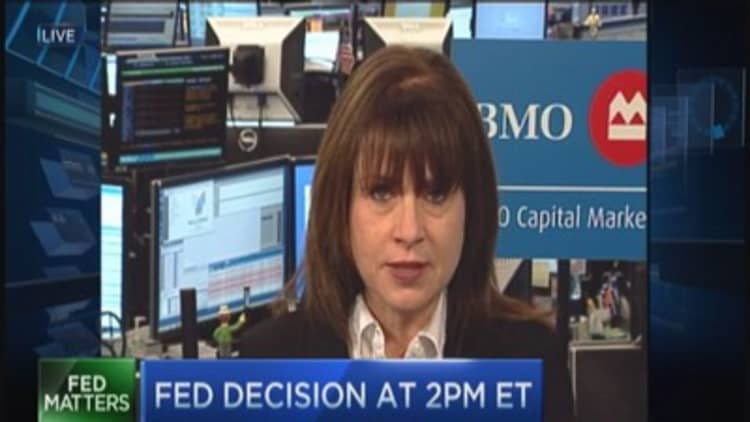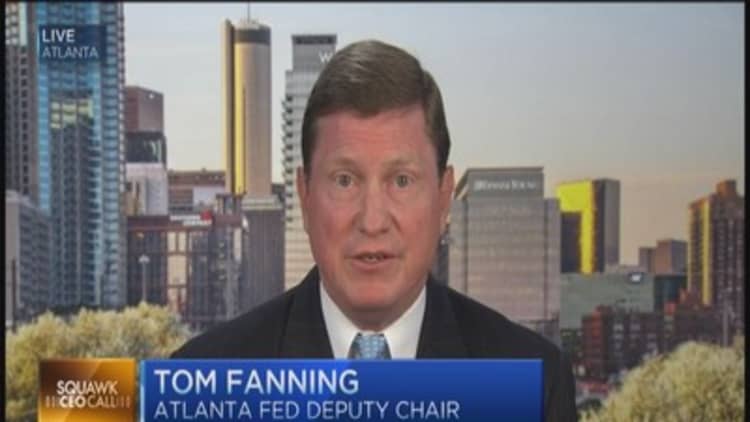
As the Fed gets set to stop QE, Wall Street is already speculating the central bank could crank up a new bond-buying program to take its place if the economy sours.
While the odds aren't high, Fed watchers, surveyed by CNBC, saw a 1-in-7 chance the central bank would launch another QE program within the next 12 months, but they saw a 1-in-6 chance of a new round of bond buying within two years. They also saw a 15.1 percent chance of a recession in the next year.
"I think at this point, people and economists, have become conditioned, and not incorrectly, that when things turn south that QE is just a part of the toolkit, rather than some sort of unusual policy," said Daniel Greenhaus, chief global strategist at BTIG. "With interest rates this low, that's probably not an unfair assumption."
Read MoreEnd of QE as we know it. Fed turns to next stage
"I think the bigger story is 1-in-6 think the economy is going to be so bad that QE would be required or called upon," he said.
A majority—64 percent—of the respondents also said there's a risk that the Fed would be more dovish than their forecasts. That answer may be at the heart of the divide between the Fed's forecasts for the first rate hike in mid-2015 and the fed fund's futures market's more dovish pricing of a first rate hike, much later, in the fourth quarter.
The CNBC survey of 39 money managers, economists and advisors shows market expectations have been pushed out for the Fed's first rate hike and how quickly rates will rise. Respondents now forecast, on average, the first rate hike in July 2015, a month later than the September survey. Instead of reaching 0.98 basis point, the average respondent now sees the Fed hiking to 0.89 basis point by the end of next year.
As for the appropriateness of Fed policy, 44 percent said it was too accommodative, and 49 percent said it was just right, the opposite to last month when 43 percent said policy was just right and 49 percent saw it as too accommodative.
Read MoreFed will go out of its way to be dovish
The Fed at 2 p.m. EDT is expected to release a statement declaring an end to the QE3 program, with the final purchases this month ending a six-year effort by the central bank to stimulate the economy with asset purchases. But the Fed is not out of business as a bond buyer. It actively replaces the maturing securities on its more than $4.4 trillion balance sheet.
Fed watchers say the Fed is unlikely to change the language in its statement about keeping rates low for a "considerable time." That was the focus of speculation last month, as was the idea that it could alter the language about labor market conditions.
"They don't want to send the wrong signal. They don't want to spook the markets. I think they'll be a little more bullish on the labor markets but they'll pivot to inflation. They'll be more worried about inflation," said Diane Swonk, chief economist at Mesirow Financial. "The markets seem pretty well prepared. The Fed has prepared them for tapering."
The focus now will be the Fed's still long path toward raising the fed funds rate from zero, where it's been since 2008. But the Fed is not likely to give any clues Wednesday about when that could start.

Besides keeping short-term rates low, Fed watchers say it hopes to suppress longer-term rates with the huge amount of bonds it holds on its more than $4.4 trillion balance sheet. The 10-year yield was at 2.31 percent Wednesday, rising ahead of the Fed statement.
Swonk also expects the Fed to remain open to another round of quantitative easing even though it wants the program to end. "They have to leave the door open to QE4, but they really don't want to do it. One of the things they made clear is they want the balance sheet steady. Is it the flow or the stock? They made clear they want to keep the balance sheet steady until they start raising rates," Swonk said. The stocks are the securities on the balance sheet, and the "flow" is the purchase of new securities.
"We've all become accustomed to QE in the sense that we lived with it for six years, but before the crisis the purchase of Treasury securities or assets at the medium to long end of the curve was always what you were supposed to do when interest rates fell to the zero bound," Greenhaus said. The idea has now become main stream after the Fed embarked on three programs and Operation Twist, a version where it bought and sold securities.
Janney Montgomery's chief investment strategist, Mark Luschini, said the markets will be looking to see if the comments made by St. Louis Fed President James Bullard earlier this month about possibly extending QE are reflected in the Fed's statement. Bullard, at a time when markets were wavering, said the Fed could actually extend QE if it was concerned about low inflation and the economy.
Read MoreMarket pushes back Fed rate hike expectations: Survey
While unlikely, "that would be a boost to equity prices," Luschini said, adding that the end of QE should not move the market, as it is much anticipated. "That's got to be well discounted at this point in time. If they dropped the 'considerable time,' that would be a big deal and that would be interpreted as hawkish," he said.


